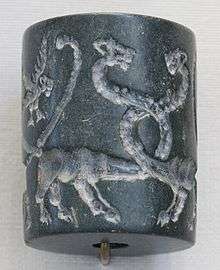Uruk period
 | |
| Geographical range | Mesopotamia |
|---|---|
| Period | Copper Age |
| Dates | c. 4000–3100 BC |
| Type site | Uruk |
| Preceded by | Ubaid period |
| Followed by | Jemdet Nasr period |
Part of a series on the |
|---|
| History of Iraq |
| Ancient Mesopotamia |
| Classical antiquity |
| Middle Ages |
| Early modern period |
| Modern Iraq |
|
|
The Uruk period (ca. 4000 to 3100 BC) existed from the protohistoric Chalcolithic to Early Bronze Age period in the history of Mesopotamia, following the Ubaid period and succeeded by the Jemdet Nasr period.[1] Named after the Sumerian city of Uruk, this period saw the emergence of urban life in Mesopotamia. It was followed by the Sumerian civilization.[2] The late Uruk period, (34th to 32nd centuries) saw the gradual emergence of the cuneiform script and corresponds to the Early Bronze Age; it may also be called the Protoliterate period.[3] It was during this period that pottery painting declined as copper started to become popular, along with cylinder seals.[4]
History of research
The term Uruk period was coined at a conference in Baghdad in 1930, where at the same time the Jemdet Nasr and Ubaid periods were defined.[5]
Dating and periodization
Periodization is after archaeological layers at Uruk. Thus, Uruk XVIII–XIV are not part of the "Uruk period" proper but are comprised by the Ubaid period. The Uruk period proper corresponds to the layers Uruk XIV–IV, with the late phase Uruk IV lasting ca. 3300–3100 BC. Uruk III reaches up to 3000 BC and into the Early Dynastic period .
Uruk expansion

Around 3600 BCE, during the Middle Uruk period, Uruk trade networks started to expand to other parts of Mesopotamia, and as far as North Caucasus.
According to Konstantine Pitskhelauri, this expansion started even earlier, at the end of the 5th millennium BC, and continued in the 4th millennium. Large masses of Uruk migrants had settled in the South, and later in the North Caucasus.[6]
The sites in this general area include Habuba Kabira in Syria, and Arslantepe in Turkey.
Uruk expansion to the northeast included sites like Godin Tepe in Iran.
Tepe Gawra, in northwest Iraq, is another important site with deep stratigraphy that includes the Uruk period in later layers.
Hamoukar is a large site in northeastern Syria that has been recently excavated. It includes Uruk and pre-Uruk layers.
Uruk enclaves have also been identified at Tell Brak and Nineveh in northern Mesopotamia, and on the Syrian Euphrates at Qrayya, and Jebel Aruda. On the Euphrates in Anatolia, Uruk enclaves were found at Hassek Hoyuk, Samsat, and Tepecik (Elazığ Province, near Keban Dam).[7]
Early city-states
These early city-states had strong signs of government organization (though social stratification was not strongly evident until very late in this period and the beginning of the Early Dynastic Period, beginning around 3100 BC), evident even in items such as cheap, mass-produced beveled rim bowls which were made to be discarded. These bowls may have been handed out at community outings, such as large-scale constructions. The cities grew to cover up to 250 acres (1 km²) and support up to 10,000–20,000 people by the end of the period.
End of the Uruk period

A few commentators have associated the end of the Uruk period with the climate changes linked to the Piora Oscillation, an abrupt cold and wet period in the climate history of the Holocene Epoch,[8] other explanation is the arrival of the East Semitic tribes represented by the Kish civilization.[9]
References
- ↑ Crawford 2004, p. 69
- ↑ Crawford 2004, p. 75
- ↑ As for example in Frankfort 1970, where the first chapter covers the period.
- ↑ Langer 1972, p. 9
- ↑ Matthews, Roger (2002), Secrets of the dark mound: Jemdet Nasr 1926-1928, Iraq Archaeological Reports, 6, Warminster: BSAI, ISBN 0-85668-735-9
- ↑ Konstantine Pitskhelauri, Uruk Migrants in the Caucasus BULLETIN OF THE GEORGIAN NATIONAL ACADEMY OF SCIENCES, vol. 6, no. 2, 2012
- ↑ Gil Stein (1998), “World Systems Theory and Alternative Modes of Interaction in the Archaeology of Culture Contact.” academia.edu
- ↑ Lamb 1995, p. 128
- ↑ Lucy Wyatt (2010-01-16). Approaching Chaos: Could an Ancient Archetype Save C21st Civilization?. p. 120. ISBN 9781846942556.
Sources
- Algaze, G. 1993. The Uruk world system: the dynamics of expansion of early Mesopotamian civilisation. Chicago; London: The University of Chicago Press
- Crawford, Harriet E. W. (16 Sep 2004). Sumer and the Sumerians (2nd ed.). Cambridge University Press. ISBN 9780521533386.
- Frankfort, Henri (1970). The Art and Architecture of the Ancient Orient. Pelican History of Art (4th ed.). Penguin. ISBN 0140561072.
- Lamb, Hubert H. (1995). Climate, History, and the Modern World. London: Routledge. ISBN 0-415-12735-1.
- Langer, William L., ed. (1972). An Encyclopedia of World History (5th ed.). Boston, MA: Houghton Mifflin Company. p. 9. ISBN 0-395-13592-3.

